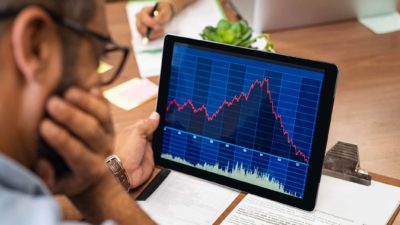Debt. It wasn't too long ago many companies were taking advantage of the unprecedented low interest rates (now just 0.25%) and issuing more to fund operations and growth.
However, in this current economic climate we are seeing many businesses being forced to close stores, and social activities are being banned or limited, with no one knowing how long this COVID-19 pandemic could last. Just recently, we have seen JB Hi-Fi Limited (ASX: JBH) along with Kathmandu Holdings Ltd (ASX: KMD) and Accent Group Ltd (ASX: AX1) closing stores.
With stores closed, company revenues will be hit hard while their fixed cost base will still need to be paid. And with little or no revenue these companies may need to dip into their cash reserves to pay interest on debt and make lease repayments. Making sure a company is capable of doing this without raising more capital or issuing more debt at an unfavourable time is important.
Below are 2 relatively simple tests you can perform to check a company's leverage and its ability to pay interest.
Interest coverage ratio
The interest coverage ratio (ICR) is calculated to determine a company's ability to pay its interest expenses on any outstanding debts. Looking at a company's most recent income statement there is usually a line item for its earnings before interest and tax (EBIT). This is exactly as it sounds. It is the company's earnings before it has paid any interest or tax. From this figure, a company will first pay its interest expenses, so it is a good measure of the company's ability to do just that – pay its interest expenses.
To calculate the ICR, take a company's EBIT and divide it by its interest expenses for the same period. This gives us the following ratio:
ICR = EBIT/interest expense
If this ratio is less than 1, it means the company will be unable to pay its current interest obligations. As a rule of thumb, I prefer companies that have a minimum interest coverage ratio of around 3x. This means during periods of depressed earnings (such as now for many companies) they will have a better chance of still being able to meet these payments from earnings.
In addition to this, many companies also have debt covenants which require them to maintain an ICR above a certain threshold. For example Rural Funds Group (ASX: RFF) has a requirement to maintain an ICR of at least 3x, with distributions permitted only when its ICR is above 3.15x. A good thing its current ICR is 5.6x.
Net debt to EBITDA ratio
Net debt is calculated by summing a company's short and long term debt and subtracting its cash and cash equivalents. So:
Net debt = short term debt + long term debt – (cash + cash equivalents)
A company's earning before interest, tax, depreciation and amortisation (EBITDA) is one step above EBIT on its income statement. We can use the below ratio as a measure of how much leverage a company has.
Net debt to EBITDA ratio = Net debt/EBITDA
This ratio shows a company's net debt divided by its earnings (that is, what it has available to pay its debt down), so it is, in theory, a rough measure of how long it would take a company to pay down its debts assuming its EBITDA is constant.
Lets make things clearer with an example from JB Hi-Fi.
JB HiFi's 1H20 report noted the following:
- Total EBITDA of $281.9 million
- Cash and equivalents of $76.8 million
- Short term debt of $1187.8m (payables + lease liabilities)
- Long term debt of $940.8 (Borrowings + lease liabilities)
Plugging all of this into the equation gives us:
Net debt = 940.8 + 1187.8 – 76.8 = 2051.8
Net debt/EBITDA = 2051.8/281.9 = 7.28
Of course, if a company holds more cash than debt, then both its net debt and net debt/EBITDA ratio would be negative – which makes sense, because it could immediately pay all debts with cash on hand.
Additionally, some industries are more capital intensive than others. As seen in the example of JB Hi-Fi, a large portion of its net debt was from lease liabilities due to its vast store network – this would be common for physical retail businesses. However, this means that there is no 'rule of thumb' for what this ratio should be for a company and as such should only be used to compare companies within the industry or business model.
For example, comparing JB Hi-Fi to an online retailer such as Kogan.com Ltd (ASX: KGN) may give misleading results. Although Kogan has lease liabilities, they are far less substantial in percentage terms for its net debt calculation, and as a result give it a net debt to EBITDA ratio of only 2.56.
Foolish takeaway
These checks may sound complicated. However like anything, once you have done 1 or 2, they become easier. Give it a go and access the financial reports from here for the company you have your eye on buying!








